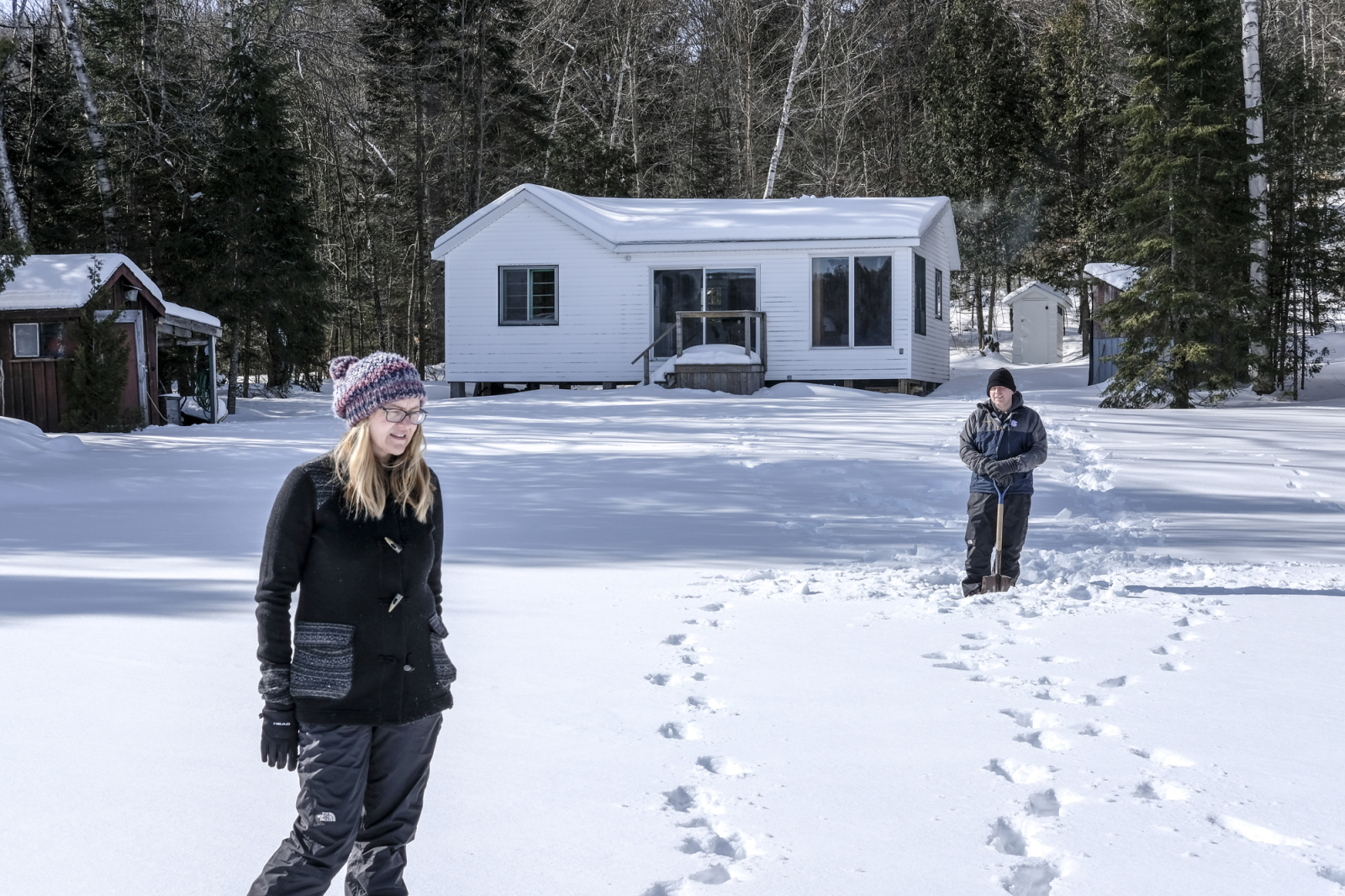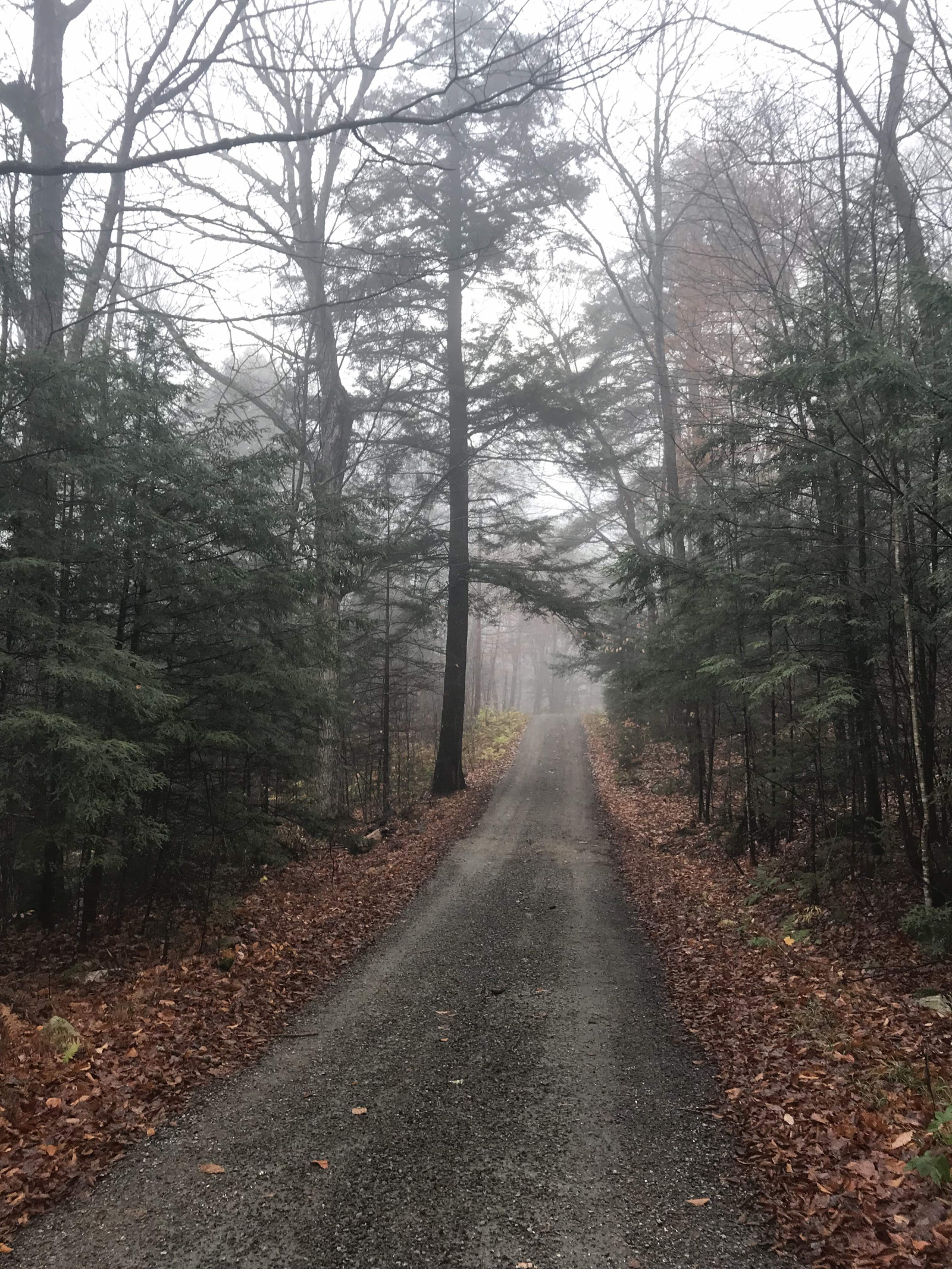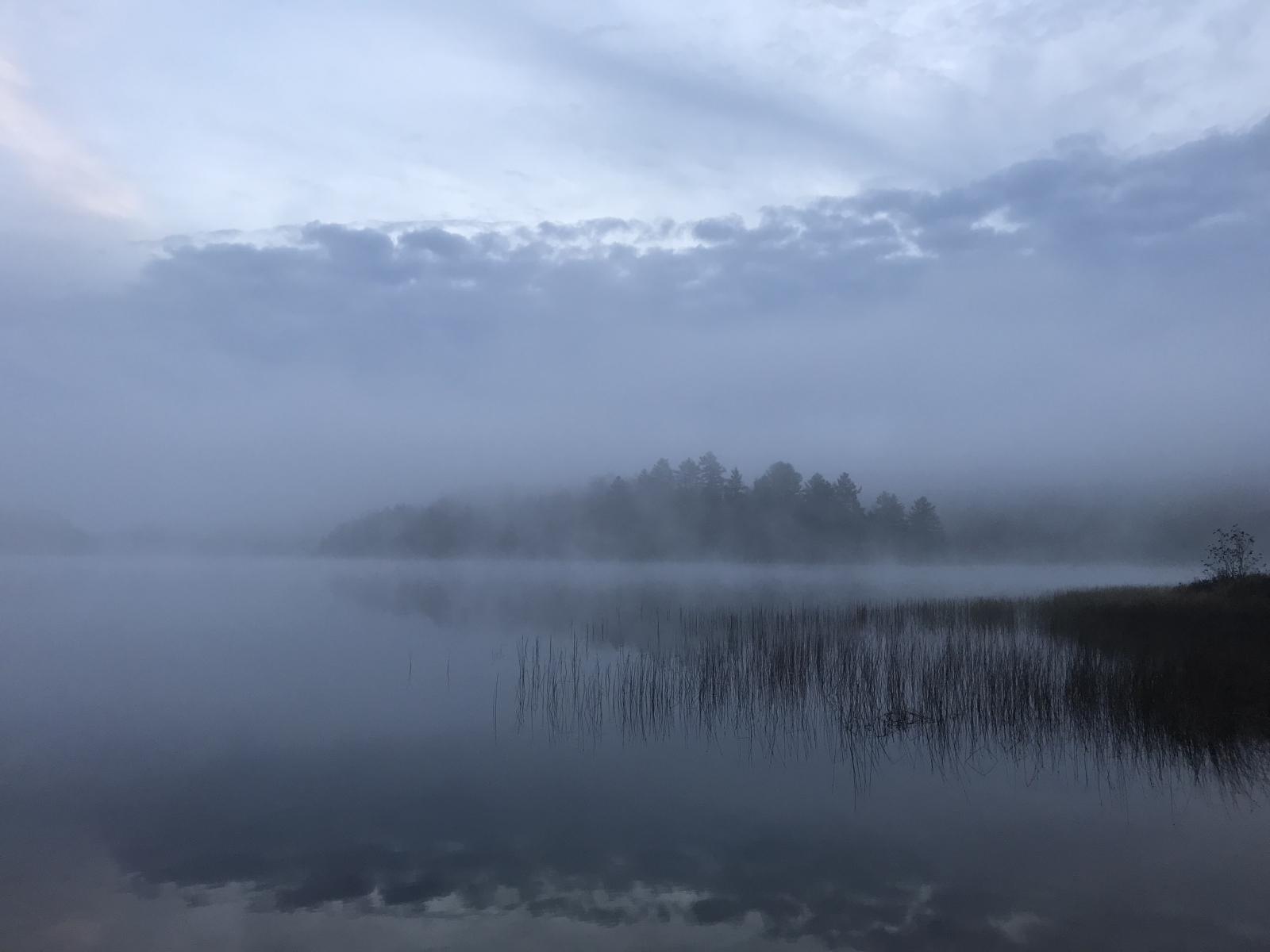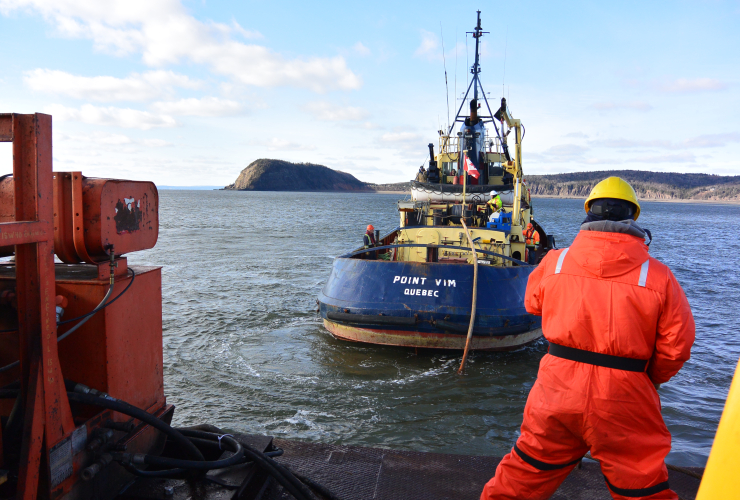Children arrive with homemade cardboard toboggans. Some are simple, resembling the classic “crazy carpet”, while others are more involved. Brothers Ryder and Finley rush down the hill aboard a winterized version of the bat mobile. Grace tumbles twice while trying her handmade three-ski sled. It's an idyllic scene today.
Every third weekend of February, the small community of Dorset, which sits on the eastern side of Lake of Bays, organizes the Snowball Winter Carnival. Residents and visitors come by car and snowmobile to watch brave souls jump into the frigid waters of Trading Bay and take part in friendly games, such as the homemade sled race.
At the bottom of the slope, three local police officers playfully use their radar gun to record their speed. Prizes are attributed in several age categories for best-decorated, fastest and furthest distance covered. Later that day, as night falls, it’s their parents’ turn to engage in jolly competition, this time on the ice rink.



The image Dorset projects is like that of many small communities north of Toronto: relaxing, fun, charming, and safe, exactly what would make city-dwellers want to buy a cottage in the area.
Harvey Lake: nature's quiet to be lost to the noisy business of quarry?
It attracted Nicole and Aaron Court, who bought a small property on Harvey Lake. With only eight neighbours, they felt like they had found a beautiful, serene, nearly untouched place to vacation with their two daughters, Emma and Tessa. That is until a letter came in early July 2017 advising them that a local businessman, Eric Doetsch, had put in a proposal to build a quarry a few hundred meters away.
“I cried for the entire weekend because I knew what the fight would mean: endless working hours. I wasn’t going to be able to sit on the dock all summer,” recalls Nicole Court.
Doetsch, co-owner of Bacher Construction Ltd, planned to transform an existing small sandpit operation located on Crown land into a 53 acres quarry, asking for a permit to extract 285,000 tons of aggregate annually. Aggregate is what you get when you crush solid rock.
According to a report in the local newspaper, The Highlander, the entrepreneur believes that the current pit will “run out of material in the next two years." He seeks to ensure the future of his family with the new pit, he says. “I want this pit to be used by my son and grandchildren. The restrictions around these proposals are getting so tough, so if I can set this up now, it just helps us in the long run.”

The road leading to the Harvey Lake cottages is not maintained in the winter, so Nicole Court makes her way on foot. Photo by Laurence Butet-Roch

Such thinking angers Nicole and Aaron Court, who feel like their children’s health is being pitted against the financial security of Doetsch’s heirs.
Their concerns regarding the impact of the proposed quarry near Harvey Lake are many. In August, they outlined 19 objections, ranging from faults in the noise and dust studies, to the risks posed to the environment and habitats of species such as the endangered Blanding’s turtle. They also cited planning inconsistencies, and the lack of monitoring, water management and treatment plans, and contingency strategies. Chief among their grievances is how the aggregate operation ignores the Algonquin Highland township's town plan. Section 5.5.8 establishes that new aggregate quarries must be further than 1,000 metres from the waterfront designation. In this case, the initial plan put the quarry at 170 metres of Harvey Lake’s shoreline.
"The whole thing boils down to three basics as far as I’m concerned. The first is that, as it stands right now, this quarry proposal violates the township plan in that it is closer than 1000 meters to the water. Secondly, it is a threat to the environment. Thirdly, there is no public benefit that I can see to a quarry on that location. We have enough quarries in the area. We do not need another gravel crushing operation,” says Gary Acker who speaks for himself and his wife, Nita, the president of the nearby Otter Lake Cottagers Association. Both have pledged support to their Harvey Lake’s counterparts. Since the road out of the proposed aggregate pit runs alongside Otter Lake, they’re also concerned about the consequences of increased truck traffic.

Nita and Gary Acker have made their Otter Lake cottage into their permanent year-round residence. Photo by Laurence Butet-Roch

However they might feel, the legality or illegality of the proposed quarry is not as easily asserted. Since it would be on Crown land, provincial authority prevails.
During a conversation with National Observer, Algonquin Highland township Councillor Brian Lynch repeatedly explained that the township does not have jurisdiction over the area and that it is up to the Ministry of Natural Resources and Forestry [MNRF] to make a decision. “It’s unfortunate that the MNRF doesn’t align with our planning system. It’s just another layer of government."
What they can do, explained the mayor, Carol Moffatt, is request that the MNRF demand that the proponent successfully obtains from the Township an Official Plan amendment and a Zoning By-Law amendment.
In July 2017, the township passed a resolution asking for just that.
“Then it would land on our table, in which case, the Council would review our planning and zoning documents, would hear from both sides and decide accordingly,” she says.

Brian Lynch, one of the town's four councillor, dressed as Snowball man for the festivities. Photo by Laurence Butet-Roch

Nicole and Aaron Court's daughter plays on frozen Harvey Lake. Photo by Laurence Butet-Roch
While the outcome is uncertain, she points to the adjacent Muskoka Township, which has rejected the application for a similar operation on private land next to Skeleton Lake after the residents made their concerns known. After an appeal from that applicant, the case is now in front of the Ontario Municipal Board.
“We put a lot of time and effort in creating a certain environment for our community through our official town plan and zoning by-laws,” she adds. “Not to be able to uphold those is frustrating.”
As far as Crown land planning goes, the area in question is slated for multiple use management, which includes aggregate extraction.
Through their spokesperson, Jamie Prentice, the Ministry asserted that any party and/or individual may voice their objections and that these are taken into consideration when making a decision to issue a permit or licence: “The ministry plays a role at key points in the process to ensure all requirements are met.
For example, the ministry reviews the application to ensure necessary information has been provided, acts as a commenting agency and reviews information collected by the proponent (e.g., Indigenous communities, public and agency comments) during the notification and circulation process.”

However, those residents of Harvey Lake and Otter Lake opposed to the quarry that National Observer spoke with don’t feel confident in the process, especially because it is proponent-driven.
In other words, they must submit their concerns to the applicant within a 30-day comment period. The proponent is then required by the Aggregate Resources Act to try to resolve any issues. Ultimately, the company sends all the documentation to the MNRF for review.
“The only way a citizen can engage is to bring the concerns to the applicant. There doesn’t seem to be, at least at this stage, active oversight or engagement by the Ministry or other regulators,” remarks Nicole Court whose main contact this entire time has been David Villard who acts as a consultant for Bacher Construction Limited. “It’s difficult to trust the process when it primarily goes through someone’s whose interest is for the application to be approved.”
In the Dorset Quarry case, Eric Doetsch held a public open house on July 29, 2017 at the Dorset Community Centre, which ended up being standing room only. The scope of the project was subsequently reduced. The permit requested is now for the extraction of 75,000 tons per year of material, while the quarry would span 35 acres and sit 500 meters away from the shoreline − twice as close as the township's 1,000 meters regulation. Nicole Court says she has yet to see the new site plans.
Doetsch refused to grant National Observer an interview. His intermediary, David Villard, stated in an email that Doetsch believed that “he has done all that has been required under the Aggregate Resources Act and is just waiting on direction from MNRF, after which we will submit our final package for MNRF’s review.'"

He has held two public sessions that were not a requirement of the application process and has taken all comments under consideration, as well as implementing all proposed mitigation measures from the various reports.”
Yet those mitigation measures do little to address the core issue, some believe. “They’ve made the whole process about mitigation, but that’s beside the point. The point is the quarry would be in the wrong place,” says Ron Crago, who with his wife, Wilma, enjoys a cottage that has been in her family since 1947 on Otter Lake. There is already truck traffic there, but the Cragos fear more truck traffic will make things far worse, destroying the peace of the relatively tranquil area. “You can mitigate all you want, but there’s still going to be noise, dust, trucks, pollution, etc.”
A question of the future: what will new seasons bring to Harvey Lake?

Harvey Lake road through woods. National Observer photo.


Those poor people, the gravel
Those poor people, the gravel trucks here in Central Alberta are deadly, just last month they rear-ended a school bus and killed a young girl, no charges were laid as the weather was foggy! Total insanity!
There is no surprise when a
There is no surprise when a pit or quarry is running out of aggregate -- companies know for years and plan accordingly. Some companies in fact buy aging licences gambling that Ontario’s Aggregate Resources Act is on their side and that they can take a decade to bully a local community into allowing expansion. So when a community initially welcomes an aggregate operation with a light at the end of the tunnel they have no idea that over time the tunnel will be lengthened and that the light will move far out of reach – likely even for their children. They also don’t know that they will have to tolerate more and more damage to their air, water, flora, fauna, peace and enjoyment of their community. If you want rehabilitation demand it now or you will never see it. #ProtectOurWater #FoodAndWaterFirst #ONpq




Comments